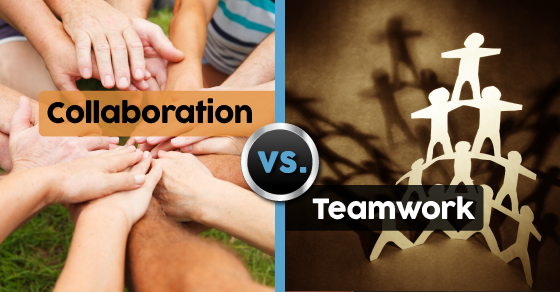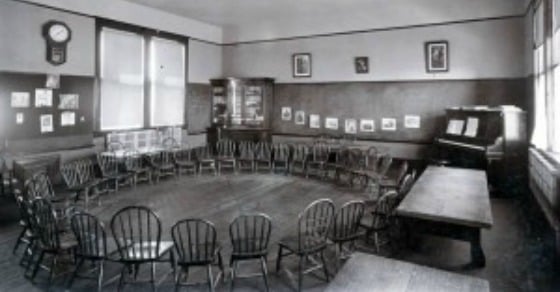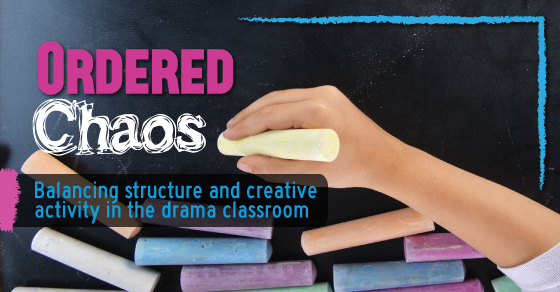There exists in everyone the potential for good or evil. Laramie Dean's adaptation of Dracula asks the question: How much would it take to bring out the darkness inside of you?
Collaboration vs. Teamwork – What’s the difference?
Collaboration has been highlighted as a 21st century skill and an important skill for students to learn. Certainly, students need to know how to work and create with others. The drama class is an ideal breeding ground to foster and develop collaboration skills. Students have to work together to create tableaux, to develop scenes and plays, to improv.
The problem occurs when collaboration and teamwork are mistaken for the same thing. The criteria for an effective collaboration are not the same as the criteria for effective teamwork. This is the definition of collaboration:
Collaboration: to work with a person or a group to produce or create something.
Doesn’t that sound like teamwork? If you struggle with getting your students to collaborate in the drama classroom, it may because you’re using a teamwork model.
What’s the difference? Which is the most important for a drama classroom?
Collaboration vs. Teamwork
The end result of collaboration or teamwork is often the same. When a group collaborates, they are working together toward a shared goal. Everyone in the group has the same vision in mind (for example: to create a performance piece about bullying). The same applies to a group of students that works as a team, they too work together toward a shared goal. Everyone is committed to a single outcome: a performance piece about bullying.
So what’s the difference?
When a group functions as a team, they are working as individuals. Everyone has their identified task which contributes to the outcome. A great example is a baseball team. Everyone has their own job – catcher, pitcher, third baseman – but they all have the same goal. A successful team depends on having a strong leader to guide the team toward the goal. If you’ve got a strong leader and a clear outcome, it’s not essential that team members like each other. This is unnecessary to complete the project, because the leader controls the work of the group. Control is key with teamwork. In a dramatic context, putting on a play is team work. The director guides the group toward its goal.
Within a collaboration the group not only has to work together, they have to think together. The end product comes from the efforts of the group. This means collaborators are equal partners – there is no leader. An example of a collaboration would be a devised theatre piece where there is no script and the group has to work together to create an end product.
Where collaboration breaks down is when students are inflexible with their contribution. Collaborators have to trust each other, respect the opinions of others, and engage in negotiations toward the final product. The best collaborators are not just creative, they are flexible. They know when to let other ideas take the lead. Flexibility is key with collaboration.
Both models are useful for students to learn. It’s important to know how to be a team player, especially within the context of staging a play. Everyone has to do their specific job well – from lighting board operator, to ensemble actor, to stage manager. It’s the job of the director to bring the team together and keep everyone on task. Even if you have students who don’t like each other, if they’re on the same page for the intended outcome, they can be effective team players.
With collaboration, it’s important for students to learn how to give and take within a project. It’s difficult to share power and to accept your idea is not always the best idea. A clear goal is essential in a collaboration, so that the project doesn’t descend into argument.
Ask yourself these questions: Do I want students to work as a team or as collaborators? Do I run my classroom as a collaboration or as a team? Which model will work best for this specific project? How do I prepare my students to excel as collaborators? How do I encourage team leaders?
Collaboration Suggestions
- Use improv as a collaboration tool. Divide students into groups and have them create scenes on the spot with location and relationship prompts. The nature of improv doesn’t give time for a leader to emerge – they have to work together and think together instantly.
- Use time limits in group work. Push students to work and think quickly.
- Encourage a “we all answer” policy when brainstorming. If a group is coming up with ideas for a scene or scenario, make it a policy that everyone has to provide a suggestion. Group work can sometimes end up with one or two leaders and then some followers. Strive to avoid this scenario.
- Encourage a “no bad ideas” policy. Yes some ideas will work better than others. But get students in the habit of accepting every idea at first. All ideas go down on the page without judgement. If a student feels their idea will be instantly judged or rejected, they will soon refuse to participate.
Teamwork Suggestions
- For some group activities, give each group member a job: Leader/Director, Note taker, Time keeper, Materials, On-Task Manager. The aim is for each member to do their job within the activity. This is something you can have students discuss or reflect on afterward – what happened within the group? What happened when students did not do their job or tried to do the job of others? What happened to the end product? As you change activities, make sure students rotate in their job assignments.
- Give every student an opportunity to be a leader. Some students struggle when put in a leadership position – there are those who are born leaders and there are those who are not. Use small, contained exercises at first. Have students lead the class in a warm up or improv game. The leader outlines the goal of the exercise, make sure everyone understands the goal and then implements the goal.
- Model the behaviour you want to see in your students. If you have students leading a game, you have to become a team member. Show students what it means to be a team player. If you want strong student leaders, show students how to lead.
- When you put on a play, make sure every student has a specific job and highlight the significance of every job. It’s easy to forget the ensemble, or to ignore the offstage crew when you’re trying to get a scene right. Teamwork relies on everyone doing their job for the good of the end goal. If students feel their job isn’t important, why would they do their best?



